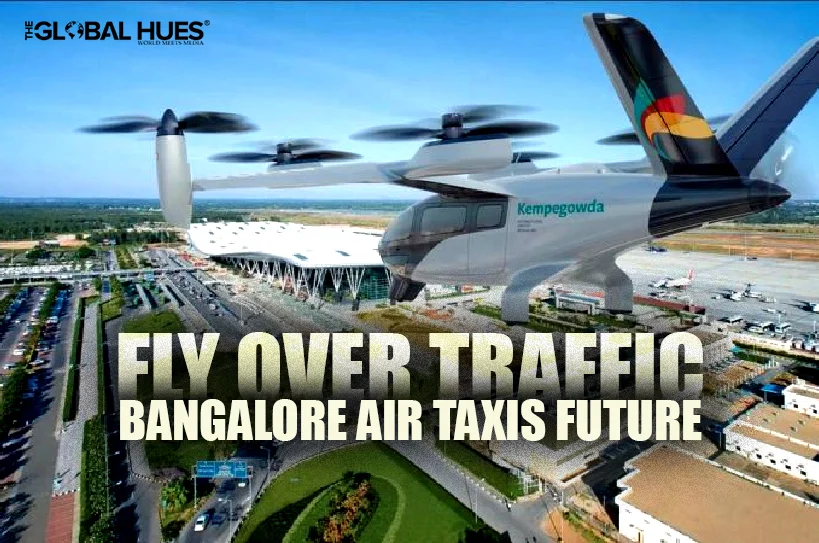Imagine you leave home early for an important meeting only to be stuck in a traffic jam. It is the most frustrating feeling to be waiting in a traffic jam and listening to the blaring noises of the horns of different vehicles. But, what if you can skip the heavy traffic, especially in a city like Bengaluru, and fly over the city air taxis to reach Kempegowda International Airport (BLR Airport)?
This might happen soon, thanks to a new partnership between Bengaluru International Airport Limited (BIAL) and Sarla Aviation. Together, they plan to offer a flying taxi service that can cut the travel time between Electronics City and the airport from 152 minutes to 19 minutes. Additionally, the ride will cost as little as Rs, 1,700.
A journey from Indiranagar to the airport takes 1.5 hours and very soon with the help of these flying electric taxis the travel time will be reduced to 5 minutes. BIAL, which operates KIA expressed its enthusiasm for the initiative as it marks their commitment to Advanced Air Mobility solutions, developed right here in Karnataka. The collaboration would lead to the creation of new operational models for seven-seater eVTOL (electric vertical takeoff and landing) aircraft aiming to revolutionise the accessibility of air travel.
What are eVTOL Flying Taxis?
eVTOLs, or electric vertical takeoff and landing aircraft represent a cutting-edge advancement in transportation technology. These vehicles are essentially flying taxis that can take off and land vertically, much like helicopters. However, unlike helicopters, they don’t rely on fossil fuels but run on electric batteries, making them a cleaner and environment-friendly option.
Additionally, they are designed for short-distance travel in urban areas to reduce travel time and bypass road traffic by flying directly to your destination. With the ability to hover, take off, and land vertically, eVTOLs require less space for landing compared to traditional aircraft. They can operate from rooftops, small airstrips, or designated areas near important landmarks like airports, business hubs, and residential neighborhoods.
What are the key features of eVTOLs?
Below are the five key features of eVTOLs:
- Vertical Take-Off And Landing
Like Helicopters, eVTOLs can take off and land without a runway.
- Environment-Friendly
The eVTOLs are powered by rechargeable batteries and they produce zero emissions, hence they are environment-friendly.
- Speed
eVTOLs can travel at speeds of up to 250 km/h, covering up to 160 kilometers on a single charge.
- Low Noise
Unlike helicopters, eVTOLs are much quieter, making them more suitable for urban environments.
- Passenger Capacity
These flying taxis can accommodate up to seven passengers comfortably, providing a viable option for group travel.
What makes these flying taxis attractive is their affordability, while many may assume that a futuristic mode of transportation would be expensive, it will not be the case. For instance, a regular taxi ride from Indiranagar to the airport currently costs around Rs 2,500. Whereas an eVTOL flying taxi ride will cost Rs 1,700, making it not only faster but also more affordable than traditional taxi services during peak hours.
What are the environmental benefits of eVTOLs?
As urban cities like Bengaluru continue to grow, the increase in traffic has led to higher carbon emissions, and air and noise pollution. eVTOLs provide a much-needed solution to these challenges by offering a zero-emission transporting option.
Traditional taxis, buses, and cars are major contributors to air pollution in urban areas. They rely on petrol or diesel, both of which emit harmful greenhouse gases. By contrast, eVTOLs are powered entirely by electricity, which can be sourced from renewable energy like solar or wind. This means that as cities transition to greener energy grids, flying taxis will become even more environmentally friendly.
Additionally, the noise pollution generated by helicopters and airplanes is a major concern in urban areas. eVTOLs, however, are designed to operate at much lower noise levels, making them suitable for densely populated areas. Their quieter engines ensure that they won’t disrupt city life, even as they operate close to residential and commercial zones.
While the potential benefits of eVTOLs are immense, there are still several challenges that need to be addressed before they become a mainstream mode of transportation. Regulatory approval, air traffic management, and safety concerns are all factors that will require careful consideration. Bengaluru is positioning itself as a leader, by setting up the necessary infrastructure and testing the technology in a controlled environment.
The Bottom Line
The introduction of eVTOLs is part of a broader trend towards urban air mobility (UAM), which aims to address the growing challenges of road traffic, air pollution, and inefficient public transport systems in cities. Furthermore, the infrastructure required for eVTOLs is minimal compared to traditional aircraft. They do not need long runways or large airports. Instead, small landing pads known as vertiports can be installed on rooftops, parking lots, or open spaces around the city.
As the technology develops and more vertiports are established, flying taxis could become a common sight in Bangalore’s skies. The question is: Would you hop on a flying taxi for your next airport trip?



